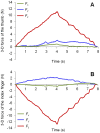Directional coordination of thumb and finger forces during precision pinch
- PMID: 24236128
- PMCID: PMC3827381
- DOI: 10.1371/journal.pone.0079400
Directional coordination of thumb and finger forces during precision pinch
Abstract
The human opposable thumb enables the hand to perform dexterous manipulation of objects, which requires well-coordinated digit force vectors. This study investigated the directional coordination of force vectors generated by the thumb and index finger during precision pinch. Fourteen right-handed, healthy subjects were instructed to exert pinch force on an externally stabilized apparatus with the pulps of the thumb and index finger. Subjects applied forces to follow a force-ramp profile that linearly increased from 0 to 12 N and then decreased to 0 N, at a rate of ± 3 N/s. Directional relationships between the thumb and index finger force vectors were quantified using the coordination angle (CA) between the force vectors. Individual force vectors were further analyzed according to their projection angles (PAs) with respect to the pinch surface planes and the shear angles (SAs) within those planes. Results demonstrated that fingertip force directions were dependent on pinch force magnitude, especially at forces below 2 N. Hysteresis was observed in the force-CA relationship for increasing and decreasing forces and fitted with exponential models. The fitted asymptotic values were 156.0 ± 6.6° and 150.8 ± 9.3° for increasing and decreasing force ramps, respectively. The PA of the thumb force vector deviated further from the direction perpendicular to the pinching surface planes than that of the index finger. The SA showed that the index finger force vector deviated in the ulnar-proximal direction, whereas the thumb switched its force between the ulnar-proximal and radial-proximal directions. The findings shed light on the effects of anatomical composition, biomechanical function, and neuromuscular control in coordinating digit forces during precision pinch, and provided insight into the magnitude-dependent force directional control which potentially affects a range of dexterous manipulations.
Conflict of interest statement
Figures







Similar articles
-
Effects of muscle fatigue on directional coordination of fingertip forces during precision grip.PLoS One. 2018 Dec 10;13(12):e0208740. doi: 10.1371/journal.pone.0208740. eCollection 2018. PLoS One. 2018. PMID: 30532161 Free PMC article.
-
Task-dependent organization of pinch grip forces.Exp Brain Res. 2007 Jun;180(2):367-76. doi: 10.1007/s00221-007-0864-9. Epub 2007 Feb 15. Exp Brain Res. 2007. PMID: 17554577
-
Control of grip force during restraint of an object held between finger and thumb: responses of muscle and joint afferents from the digits.Exp Brain Res. 1996 Feb;108(1):172-84. doi: 10.1007/BF00242914. Exp Brain Res. 1996. PMID: 8721165
-
Quantifying Digit Force Vector Coordination during Precision Pinch.J Mech Med Biol. 2013 Apr 2;13(2):1350047. doi: 10.1142/S0219519413500474. J Mech Med Biol. 2013. PMID: 24443624 Free PMC article.
-
Hydrodynamic analysis of different finger positions in swimming: a computational fluid dynamics approach.J Appl Biomech. 2015 Feb;31(1):48-55. doi: 10.1123/jab.2013-0296. Epub 2014 Sep 15. J Appl Biomech. 2015. PMID: 25222969 Review.
Cited by
-
Coordination of digit force variability during dominant and non-dominant sustained precision pinch.Exp Brain Res. 2015 Jul;233(7):2053-60. doi: 10.1007/s00221-015-4276-y. Epub 2015 Apr 14. Exp Brain Res. 2015. PMID: 25869742
-
Wireless Sensing of Lower Lip and Thumb-Index Finger 'Ramp-and-Hold' Isometric Force Dynamics in a Small Cohort of Unilateral MCA Stroke: Discussion of Preliminary Findings.Sensors (Basel). 2020 Feb 23;20(4):1221. doi: 10.3390/s20041221. Sensors (Basel). 2020. PMID: 32102239 Free PMC article.
-
Finger-mounted quantitative micro-elastography.Biomed Opt Express. 2019 Mar 11;10(4):1760-1773. doi: 10.1364/BOE.10.001760. eCollection 2019 Apr 1. Biomed Opt Express. 2019. PMID: 31086702 Free PMC article.
-
Maximum trunk tip force assessment related to trunk position and prehensile 'fingers' implication in African savannah elephants.PLoS One. 2024 May 14;19(5):e0301529. doi: 10.1371/journal.pone.0301529. eCollection 2024. PLoS One. 2024. PMID: 38743734 Free PMC article.
-
Biomechanical Characteristics of Hand Coordination in Grasping Activities of Daily Living.PLoS One. 2016 Jan 5;11(1):e0146193. doi: 10.1371/journal.pone.0146193. eCollection 2016. PLoS One. 2016. Retraction in: PLoS One. 2016 Mar 04;11(3):e0151685. doi: 10.1371/journal.pone.0151685. PMID: 26730579 Free PMC article. Retracted.
References
-
- Dun SC, Li ZM (2005) Visualization of multidigit manipulation mechanics: Manipulation mechanics. IEEE T Instrum Meas 54: 2336–2341.
-
- Li ZM (2002) Inter-digit co-ordination and object-digit interaction when holding an object with five digits. Ergonomics 45: 425–440. - PubMed
Publication types
MeSH terms
Grants and funding
LinkOut - more resources
Full Text Sources
Other Literature Sources
Miscellaneous

